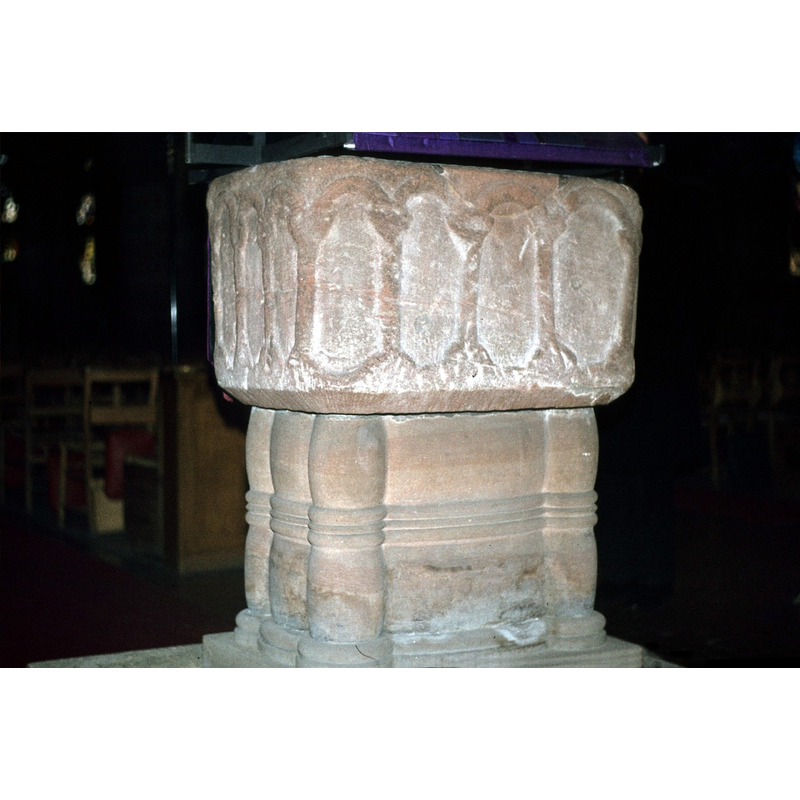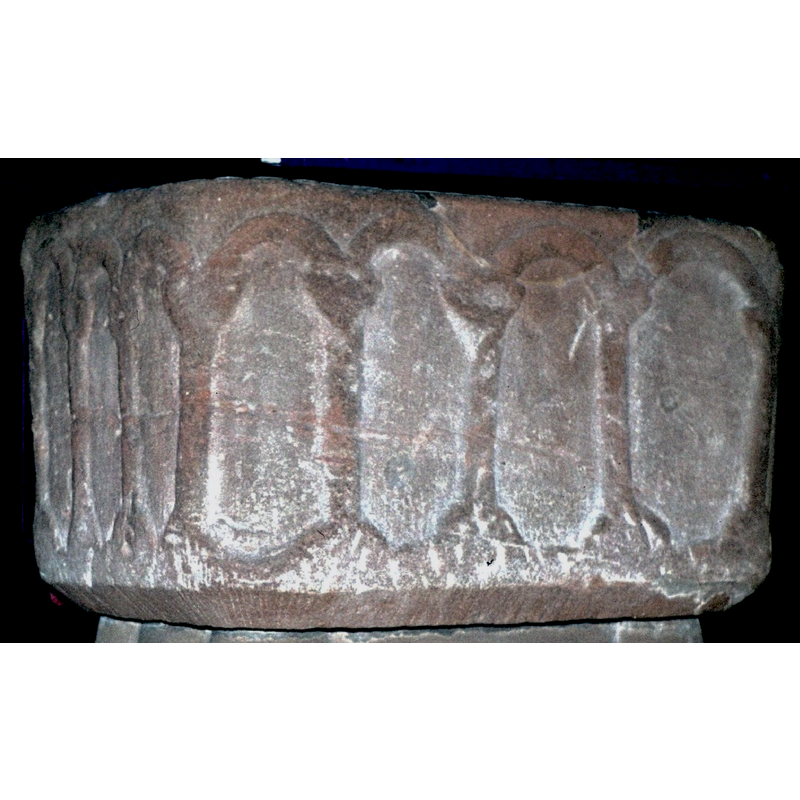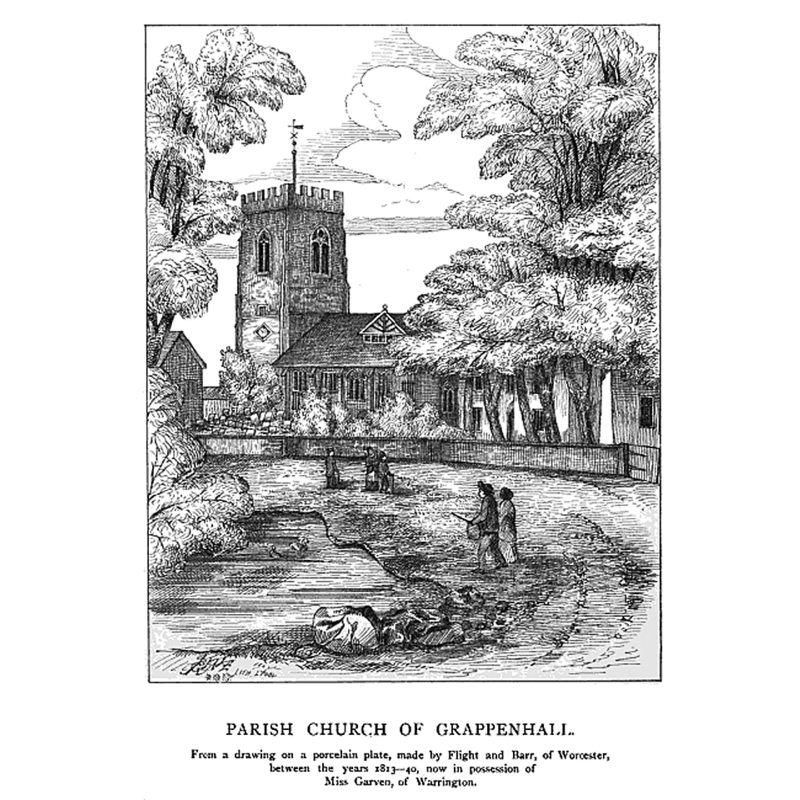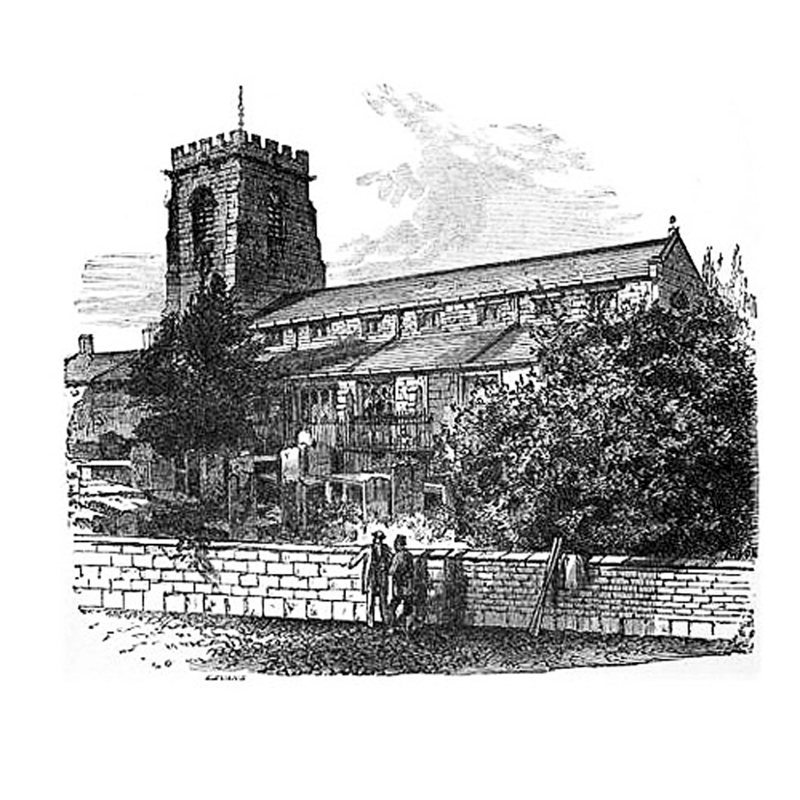Grappenhall nr. Warrington

Image copyright © Timothy Marlow, 2015
Image and permission received (letter of 26 October 2013)
Results: 7 records
design element - architectural - arcade - blind - round arches - columns with capitals and bases
Scene Description: one of the repairs to the upper rim is quite clearly visible here
Copyright Statement: Image copyright © Timothy Marlow, 2015
Image Source: detail of a photograph taken 30 April 1979 by Timothy Marlow
Copyright Instructions: Image and permission received (letter of 26 October 2013)
view of basin
view of basin
Scene Description: it shows the large damaged spots at opposite ends of the upper rim, where the metal staples of the old cover broke the stone -- [NB: is this Jonathan Edward Warrall (1829-1913), the painter?]
Copyright Statement: Image copyright © [in the public domain]
Image Source: edited detail of a drawing by "J E Warrall, del", in Smith (1874)
Copyright Instructions: PD
view of church exterior - southeast view
view of church exterior - southeast view
view of font
Scene Description: the base is a Victorian replacement of Anglo-Saxon inspiration [cf. FontNotes]
Copyright Statement: Image copyright © Timothy Marlow, 2015
Image Source: photograph taken 30 April 1979 by Timothy Marlow
Copyright Instructions: Image and permission received (letter of 26 October 2013)
INFORMATION
FontID: 01432GRA
Object Type: Baptismal Font1
Church/Chapel: Parish Church of St. Wilfrid
Church Patron Saints: St. Wilfrid [aka Wilfred, Wilfrith]
Church Location: Church Lane, Grappenhall, Cheshire, WA4 3EP
Country Name: England
Location: Cheshire, North West
Directions to Site: Located near Warrington
Ecclesiastic Region: Diocese of Chester
Historical Region: formerly Lancashire
Font Location in Church: Inside the church, at the W end of the nave, beneath the W tower
Date: ca. 1120?
Century and Period: 12th century [basin only] -- 19th century [base only] [composite font], Medieval [composite]
Credit and Acknowledgements: We are grateful to Timothy Marlow for his photographs of this font
Font Notes:
Click to view
Smith (1874) cites the discovery of the font in 1873 from a communication by William Beamont to the Warrington Guardian. "the ancient Font of an older church [...] which goes back to Norman, if not to times still earlier [...] found lying near the base of the second pillar from the west end, and three or more feet below the floor". Smith (ibid.) identifies the stone as "red sandstone of the country". In his article on Grappenhall St. Wilfrid', Barns (1881) writes: "The church may be described in general terms as a Late Perpendicular building [...] incorporating the remains of an ancient Romanesque church and a chantry of the Decorated style [...] There is some doubt as to whether the remains of Romanesque work belong to the eleventh or twelfth century; and if to the eleventh, whether to the earlier or Anglo Saxon period, or to that subsequent to the Norman Conquest [...] The existence of the remains of a rude corbel table, of early character, now in the interior of the south aisle, and of the font discovered during the restoration of 1873, are incontrovertible proofs of the early foundation of the church; and this is supported by the mention of a certain Robert, who was parson of Grappenhall in 1189 [...] From the rudeness of the font, however, and from the dedication of the church to St. Wilfrid, a pre-Norman or Anglo Saxon origin has been claimed for the first erection of a church at Grappenhall [...] The sculpture on the font is said to resemble the character of Saxon work, and the sketches in the 'Benedictional of St Æthelwold', an illuminated MS. of the close of the 10th century [...] The font, although rude in its ornamentation, will scarcely of itself give support to the Anglo-Saxon theory. The arches sculptured round it certainly do not claim any great artistic merit, but this may quite as likely be caused by the inferiority of workmanship as by the earliness of its date. In a remote village such as Grappenhall it is probable that the works were carried on by village masons and the Grappenhall font is of a character which might well refer it to such an origin." Barns (ibid.) compares the arcade of this font with the one on the font at Gillingham, Kent, dated to the 12th century. Barns provides a full description of the font, "which was discovered and rescued from destruction by the rector of the parish, the Rev. Thomas Greenall, during the restoration in March. 1873. It was dug up from a depth of between three and four feet below the floor of the nave, and near the second pier from the west. It is oblong in shape and of the following dimensions [cf. Description area below] [...] The material of which it is made is the red sandstone of the county; and its ornamentation is very rude [...] This rude ornamentation consists of a series of semicircular arches in shallow relief, which are continued unbroken round the corners of the font. These arches, which are of no uniform height, rest on piers with capitals and bases of early character, yet bearing a certain resemblance in their proportion to those in the crypt of Canterbury, of the early part of the 12th century but the piers instead of being perpendicular to the base of the font or parallel to one another, slope in every conceivable direction, thus enhancing the rude character of the work [...] Grappenhall font corresponds with the average dimensions of the Norman fonts [...] At the present time there exists in the middle of each of the longer sides a hollow in the rim, due to the wrenching away of the staples to which the cover was fastened." Listed in Cox & Harvey (1907) as a baptismal font of the Norman period; it "was found under the floor in 1874". The font and some of its history are described in a lecture by Arthur Mounfield, recorded in 'The Warrington Examiner' of June 2nd and 9th 1923 [the substance of it matches the description in the CRSBI below] [source: http://bodell_mick.tripod.com/Boydell/id15.html]. Richards (1973) quotes from the Helsby edition of Ormerod's Cheshire (vol. I: 597) the following excerpt related to the restoration of the church in 1874: "During the progress of the work, when the floor was being lowered to uncover the bases of the pillars which had been buried, the workmen found an oblong font, of the Norman period, made from red sandstone". Described and illustrated in the CRSBI (2008): "The bowl is roughly rectangular, broader from N to S than from E to W. The angles are rounded, and the lower rim chamfered. The surface is carved in a continuous arcade of 16 segmental-headed bays, which occupy both the faces and the rounded corners. The arcade is in low relief. Columns are flat fillets; the arches are of roll profile; bases are mounds and capitals inverted cones. The carving is irregular in terms of the spacing of the shafts and even their verticallity. The bowl is of red sandstone, lead lined. Where the rim has been damaged by the removal of locks, inserts carved to copy the design have been put in. The bowl was discovered buried under the nave during the restoration of 1874, and it stands on a base of Anglo-Saxon character, made for it in that year." Listed in Stocker (1997) as a "deep burial" instance in his listing of "font bowls reportedly discovered under church floors and set beneath successors." Noted in Pollard & Pevsner (2006): "Font. Norman [...] restored on new base."
COORDINATES
Church Latitude & Longitude Decimal: 53.3723, -2.5434
Church Latitude & Longitude DMS: 53° 22′ 20.28″ N, 2° 32′ 36.24″ W
UTM: 30U 530378 5913784
MEDIUM AND MEASUREMENTS
Material: stone, sandstone (red)
Number of Pieces: two
Font Shape: rectangular (mounted)
Basin Interior Shape: rectangular
Basin Exterior Shape: rectangular
Drainage Notes: lead-lined
Diameter (inside rim): 37.5 x 56.25 cm* -- 38 x 57 cm**
Basin Depth: 25 cm*
Height of Basin Side: 45 cm* -- 48 cm**
Trapezoidal Basin: 60 x 79 cm*/**
Notes on Measurements: * [in ft./in. in Smith (1874) and Barns (1881)] -- ** [CRSBI]
LID INFORMATION
Notes: [cf. FontNotes regarding the removed hardware of the original cover]
REFERENCES
Barns, Thomas, "The architectural antiquities of the Parish Church of St. Wilfrid, Grappenhall, Co. Chester", XXXIII (1881), Transactions of the Historic Society of Lancashire and Cheshire, 1881, pp. 85-122; p. 86-96
Berry, G., A History of Grappenhall Church, 2000
Corpus of Romanesque Sculpture in Britain and Ireland, The Corpus of Romanesque Sculpture in Britain and Ireland, The Corpus of Romanesque Sculpture in Britain and Ireland. Accessed: 2004-08-16 00:00:00. URL: http://www.crsbi.ac.uk.
Cox, John Charles, English Church Furniture, New York: E.P. Dutton & Co., 1907
Mounfield, Arthur, "Grappenhall and its Antiquities", 1923, June 2nd and 9th, The Warrington Examiner, 1923
Ormerod, George, The History of the county palatine and city of Chester, [...], Manchester: E.J. Morten, 1980 c1882
Pevsner, Nikolaus, Cheshire, Harmondsworth: Penguin Books, 1971
Pollard, Richard, Lancashire: Liverpool and the South-West, New Haven, London: Yale University Press, 2006
Richards, Raymond, Old Cheshire Churches, 1947
Richards, Raymond, Old Cheshire churches: a survey of their history, fabric and furniture with records of the older monuments, with a supplementary survey relating to the lesser old chapels of Cheshire, Didsbury, Manchester: E.J. Morten, 1973
Smith, Henry Ecroyd, "Archaeology of the Mersey District, 1873, and Liverpool Notabilia", II (3rd series), Transactions of the Historic Society of Lancashire and Cheshire, 1874, pp. [83]-139; p. 84ff, plate III, 108
Stocker, D.A., "Fons et origo: The Symbolic Death and Resurrection of English Font Stones", I (1997b), Church Archaeology, 1997, pp. 17-25; p. 24

![drawing signed "J E Warrall, del" [NB: is this Jonathan Edward Warrall (1829-1913), the painter?]](/static-50478a99ec6f36a15d6234548c59f63da52304e5/compressed/0130329045_compressed.png)
![it shows the large damaged spots at opposite ends of the upper rim, where the metal staples of the old cover broke the stone -- [NB: is this Jonathan Edward Warrall (1829-1913), the painter?]](/static-50478a99ec6f36a15d6234548c59f63da52304e5/compressed/0130329046_compressed.png)


